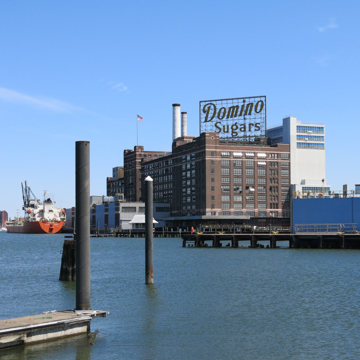The massive neon “Domino Sugars” sign on the roof of this refining plant is arguably one of Baltimore’s most recognizable icons and a symbol of this city’s historic importance in the sugar-processing industry. Built by the American Sugar Refining Company in one campaign and extending to the harbor on pilings, this sprawling plant was one of the largest sugar refineries in the United States for many decades. It featured a state-of-the-art pressure filtration system for purifying the liquefied sugar that allowed faster production with less labor than older gravity-fed systems. The complex comprises sixteen structures, including four reinforced-concrete processing buildings, offices, warehouses, and ancillary buildings. Currently the refinery continues to process about seven million pounds of sugar a day with about six hundred employees. An LED replica of the original neon sign was installed in 2021.
You are here
DOMINO SUGAR FACTORY
If SAH Archipedia has been useful to you, please consider supporting it.
SAH Archipedia tells the story of the United States through its buildings, landscapes, and cities. This freely available resource empowers the public with authoritative knowledge that deepens their understanding and appreciation of the built environment. But the Society of Architectural Historians, which created SAH Archipedia with University of Virginia Press, needs your support to maintain the high-caliber research, writing, photography, cartography, editing, design, and programming that make SAH Archipedia a trusted online resource available to all who value the history of place, heritage tourism, and learning.















